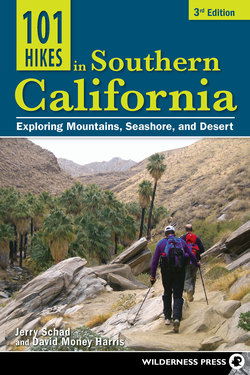Читать книгу 101 Hikes in Southern California - Jerry Schad - Страница 13
На сайте Литреса книга снята с продажи.
ОглавлениеUsing This Book
THERE ARE THREE PRINCIPAL WAYS to find hiking trips in this book that are suitable for you. First, you can check the overview map for all 101 hikes in this book, pages x–xi, and restrict your search to a specific geographic area. Second, you can scan the hike overview table (pages xii–xv) that appears after the overview map. Third, you can leaf through the book, browsing hike summaries, descriptions, and photos.
To get the most out of this guide, please take the time to carefully read, below, about the meaning of the capsulized information that appears before each hike description.
Sketch maps are provided for each hike. The boxed T (trailhead) symbol on each map denotes the start point of the hike it depicts, and it lists the GPS coordinates for the trailhead in decimal degrees. One-way (point-to-point) hikes have two T symbols—one for the beginning of the hike and one for end of the hike. For nearly all hikes described in this book, the sketch map we provide is adequate for basic navigation. For a few hikes, the capsulized summary recommends a specific detailed topographic map by name.
Capsulized Summaries
Each hike begins with a capsulized summary that details its location, highlights, distance, elevation gain and loss, time required, optional or recommended maps, best times, managing agency, difficulty rating, and trail uses.
Location. The general location of the hike is stated: a well-known park, mountain range, or nearby city or town.
Highlights. One or two engaging features of the hike are mentioned.
Distance. An estimate of total distance is given. For hikes shorter than 6 miles, the distance is given to the nearest tenth of a mile. For hikes 6 miles and longer, their distance is rounded to the nearest whole number. Out-and-back trips show the sum of the distances of the out-and-back segments. This section also indicates what type of trip it is: out-and-back, one way, or loop.
Total Elevation Gain/Loss. These are estimates of the sum of all the vertical gain segments and the sum of all the vertical loss segments along the total length of the route (both ways for out-and-back trips). This is often considerably more than the net difference in elevation between the high and low points of the hike.
Hiking Time. This figure is for the average hiker, and includes only the time spent in motion. It does not include time spent for rest stops, lunch, and so on. Fast walkers can complete the routes in perhaps 30% less time, and slower hikers may take 50% longer. We assume the hiker is traveling with a light day pack. (Important note: The hiking time stated in this book is for time-in-motion only. Also, hikers carrying heavy packs could easily take nearly twice as long, especially if they are traveling under adverse weather conditions. Remember, too, that the progress made by a group as a whole is limited by the pace of its slowest member.)
Optional or Recommended Map(s). The topographic maps listed are nearly all U.S. Geological Survey 7.5-minute series topographic maps. Usually, these are the most complete and accurate maps of the physical features (if not always the cultural features and trails) of the area you’ll be traveling in. These maps are typically stocked by backpacking, outdoor sports, and map shops around the Southland. Topographic maps available on CD or downloadable from the Internet are popular alternatives to hard-copy topographic maps.
Best Times. Because of the extreme heat, avoid the longer desert trips in this book during any period except the one recommended here. Trips elsewhere in Southern California are usually safe enough, but less rewarding, outside their best times.
Agency. These code letters refer to the agency or office that has jurisdiction over or manages the area being hiked (for example, CNF/TD means Cleveland National Forest, Trabuco District). Contact the agency for more information about a particular hike and its current regulations. Full names, phone numbers, and some addresses (of larger agencies) are listed in “Agencies and Information Sources” (page 267).
Difficulty. This subjective, overall rating takes into account the length of the hike and the nature of the terrain. The following are general definitions of the five categories:
Easy. Suitable for every member of the family.
Moderate. Suitable for all physically fit people.
Moderately strenuous. Long length, substantial elevation gain, and/or difficult terrain. Recommended for experienced hikers only.
Strenuous. A full day’s hike (or a backpack trip) over a long and/or challenging route. Suitable only for experienced hikers in excellent physical condition.
Very strenuous. Long and rugged route in extremely remote area. Suitable only for experienced hikers or climbers in top physical condition. Only three hikes in this book—Down the East Fork (Hike 30), San Jacinto Peak: Hard Way (Hike 53), and Villager Peak (Hike 96)—get this rating.
Each higher level represents more or less a doubling of the difficulty.
Trail Use. This field mentions whether dogs are allowed, whether a given hike is appropriate for kids, and more.
Permit. This section is included only for trips that require permits, usually for overnight use.
Sunrise on Mugu Peak (Hike 3)
